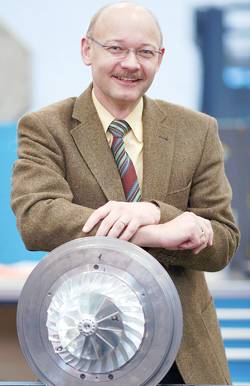At the Marintec 2011 marine trade show in Shanghai, ABB Turbocharging announced its latest move: the start of production in China of its most modern high pressure single stage turbocharger for low speed 2-stroke engines, the A100-L. ABB Turbocharging’s involvement in the Chinese market started in December 1978 with the conclusion of a license agreement with the organization that subsequently became its joint venture partner, Chongqing Jiangjin Turbo & Charger Machinery Co., Ltd, a subsidiary of the China Shipbuilding Industry Corporation. In parallel, on the after-sales side a service network was installed, mainly for turbochargers on the ships of Chinese owners. The ABB Jiangjin Turbo Systems Co., Ltd, joint venture was forged in 2006 and, as the next step, 2009 saw the opening of the state-of-the-art turbocharger factory in Jiangjin, close to the previous place of manufacture.
“The driving force behind this progressively increasing commitment has been our strategy of always providing Chinese engine builders and end users full access to the new products and service offerings they need,” said Oliver Riemenschneider, head of the global ABB Turbocharging Business Unit. “To get this right, we have to fully connect with the engine builders of China, supporting their development efforts with our local team of application engineers, dedicated to the Chinese market and constantly in contact with it.”
The feedback gathered from these contacts and extensive market research pointed in the same direction: the time had come to localize the A100 turbocharger generation. “This is triggered by the expansion of licensed production of 2-strokes as a result of China’s intention to be the global number one in shipbuilding,” Riemenschneider said.
The first A100-L turbocharger to leave the Jiangjin factory “is an example of the A165-L, the smallest A100-L model, and will be fitted to one of the first examples of a new, small bore 2-stroke engine to be produced at the brand new factory of a brand new player in the 2-stroke engine market,” Riemenschneider said. “I am talking about a 6 cylinder model of Wärtsilä’s new 35 cm bore RT-flex35, from a series being built by Yuchai Marine Power Co. at its recently completed factory in Doumen, in the southwest of China.” The engines will be used in a series of 20,000 DWT bulk carriers being built at a shipyard in Fujian province.
A100-L
“During its final development stages an A190-L turbocharger for low speed 2-stroke engines set a new efficiency record for an ABB turbocharger of well over 75%,” Riemenschneider said. “Significantly, the record was achieved at a higher pressure ratio than the previous best – the A100-L is capable of producing pressure ratios in the range 4.7 to 5.1.” This combination of high pressure ratios and high efficiency enables manufacturers of low speed 2-stroke diesel engines to reduce the effects of the so-called “NOx-SFC trade-off”. This is principally achieved by transferring the work of compressing the combustion air from the piston to the turbocharger, so that more useful power is available at the crankshaft. “In daily commercial operation, fuel savings as high as 2 g /kWh are being achieved aboard a wide range of vessel types. For a 50 MW rated low-speed engine burning heavy fuel oil (HFO), and assuming a fuel price of $500 per ton, this amounts to savings of $ 300,000 over a typical 6000 hour operating year,” Riemenschneider said.
Local production of the A100-L means the Jiangjin factory now manufactures modern turbochargers for both 2-stroke and 4-stroke engines. While growth in shipbuilding is currently the major contributor, China is positioning to become the most important market for large engines in the world overall.
“The diversification we will see in the demand for turbochargers will set the pattern for the future and is mirrored in the unique combination of ownership and design bases we need to supply in China,” Riemenschneider said. “These comprise licensees like Yuchai Marine Power Co.; local Chinese engine builders; joint venture companies bringing together local producers and western manufacturers; and implants by the leading international engine builders. There will be big demands on engine system and component suppliers like us to cover whole ranges of, predominantly, four stroke applications.”
Looking at specific 4-stroke growth sectors, considerable demand is forecast for the coastal and inland waterways vessels which play such a big part in China’s transport infrastructure. “As in several sectors in China, renewal of engines and engine technology will be strongly dependent on the introduction of emissions legislation,” Riemenschneider said. “Judging by the preparations we are seeing, this will certainly happen and low emissions engines with acceptable fuel consumption will require the latest turbocharging technology.
In fact, there is even the possibility of the Chinese engine industry doing a double step on engines powering inland and coastal ships, straight from older diesels to the latest gas and dual fuel engine technology, given that new reserves of gas have been found in China and a supply infrastructure is being installed.”














